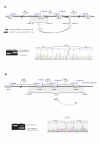Large genomic rearrangements in the CFTR gene contribute to CBAVD
- PMID: 17448246
- PMCID: PMC1876208
- DOI: 10.1186/1471-2350-8-22
Large genomic rearrangements in the CFTR gene contribute to CBAVD
Abstract
Background: By performing extensive scanning of whole coding and flanking sequences of the CFTR (Cystic Fibrosis Transmembrane Conductance Regulator) gene, we had previously identified point mutations in 167 out of 182 (91.7%) males with isolated congenital bilateral absence of the vas deferens (CBAVD). Conventional PCR-based methods of mutation analysis do not detect gross DNA lesions. In this study, we looked for large rearrangements within the whole CFTR locus in the 32 CBAVD patients with only one or no mutation.
Methods: We developed a semi-quantitative fluorescent PCR assay (SQF-PCR), which relies on the comparison of the fluorescent profiles of multiplex PCR fragments obtained from different DNA samples. We confirmed the gross alterations by junction fragment amplification and identified their breakpoints by direct sequencing.
Results: We detected two large genomic heterozygous deletions, one encompassing exon 2 (c.54-5811_c.164+2186del8108ins182) [or CFTRdele2], the other removing exons 22 to 24 (c.3964-3890_c.4443+3143del9454ins5) [or CFTRdele 22_24], in two males carrying a typical CBAVD mutation on the other parental CFTR allele. We present the first bioinformatic tool for exon phasing of the CFTR gene, which can help to rename the exons and the nomenclature of small mutations according to international recommendations and to predict the consequence of large rearrangements on the open reading frame.
Conclusion: Identification of large rearrangements further expands the CFTR mutational spectrum in CBAVD and should now be systematically investigated. We have designed a simple test to specifically detect the presence or absence of the two rearrangements identified in this study.
Figures


Similar articles
-
Detection of cystic fibrosis transmembrane conductance regulator (CFTR) gene rearrangements enriches the mutation spectrum in congenital bilateral absence of the vas deferens and impacts on genetic counselling.Hum Reprod. 2007 May;22(5):1285-91. doi: 10.1093/humrep/dem024. Epub 2007 Feb 28. Hum Reprod. 2007. PMID: 17329263
-
Mutations of the CFTR gene in Turkish patients with congenital bilateral absence of the vas deferens.Hum Reprod. 2004 May;19(5):1094-100. doi: 10.1093/humrep/deh223. Epub 2004 Apr 7. Hum Reprod. 2004. PMID: 15070876
-
Molecular analysis of the IVS8-T splice variant 5T and M470V exon 10 missense polymorphism in Iranian males with congenital bilateral absence of the vas deferens.Mol Hum Reprod. 2006 Jul;12(7):469-73. doi: 10.1093/molehr/gal046. Epub 2006 May 19. Mol Hum Reprod. 2006. PMID: 16714368
-
[Molecular basis of cystic fibrosis and congenital bilateral agenesis of vas deferens].Contracept Fertil Sex. 1996 Jun;24(6):495-500. Contracept Fertil Sex. 1996. PMID: 8766513 Review. French.
-
CFTR mutations and polymorphisms in male infertility.Int J Androl. 2004 Oct;27(5):251-6. doi: 10.1111/j.1365-2605.2004.00485.x. Int J Androl. 2004. PMID: 15379964 Review.
Cited by
-
Genetic analysis and intracytoplasmic sperm injection outcomes of Chinese patients with congenital bilateral absence of vas deferens.J Assist Reprod Genet. 2022 Mar;39(3):719-728. doi: 10.1007/s10815-022-02417-z. Epub 2022 Feb 4. J Assist Reprod Genet. 2022. PMID: 35119551 Free PMC article.
-
Azoospermia: vasal agenesis.Asian J Androl. 2022 Jan-Feb;24(1):1-4. doi: 10.4103/aja.aja_113_19. Asian J Androl. 2022. PMID: 31621656 Free PMC article. No abstract available.
-
Analysis of CNVs of CFTR gene in Chinese Han population with CBAVD.Mol Genet Genomic Med. 2020 Nov;8(11):e1506. doi: 10.1002/mgg3.1506. Epub 2020 Sep 19. Mol Genet Genomic Med. 2020. PMID: 32951344 Free PMC article.
-
Genetics of the congenital absence of the vas deferens.Hum Genet. 2021 Jan;140(1):59-76. doi: 10.1007/s00439-020-02122-w. Epub 2020 Feb 5. Hum Genet. 2021. PMID: 32025909 Free PMC article. Review.
-
Correlation between CFTR variants and outcomes of ART in patients with CAVD in Central China.Sci Rep. 2023 Jan 5;13(1):64. doi: 10.1038/s41598-022-26384-8. Sci Rep. 2023. PMID: 36604502 Free PMC article.
References
-
- Claustres M. Molecular pathology of the CFTR locus in male infertility. Reprod Biomed Online. 2005;10:14–41. - PubMed
-
- Cystic Fibrosis Mutation Database http://www.genet.sickkids.on.ca/cftr/app
Publication types
MeSH terms
Substances
LinkOut - more resources
Full Text Sources
Medical

